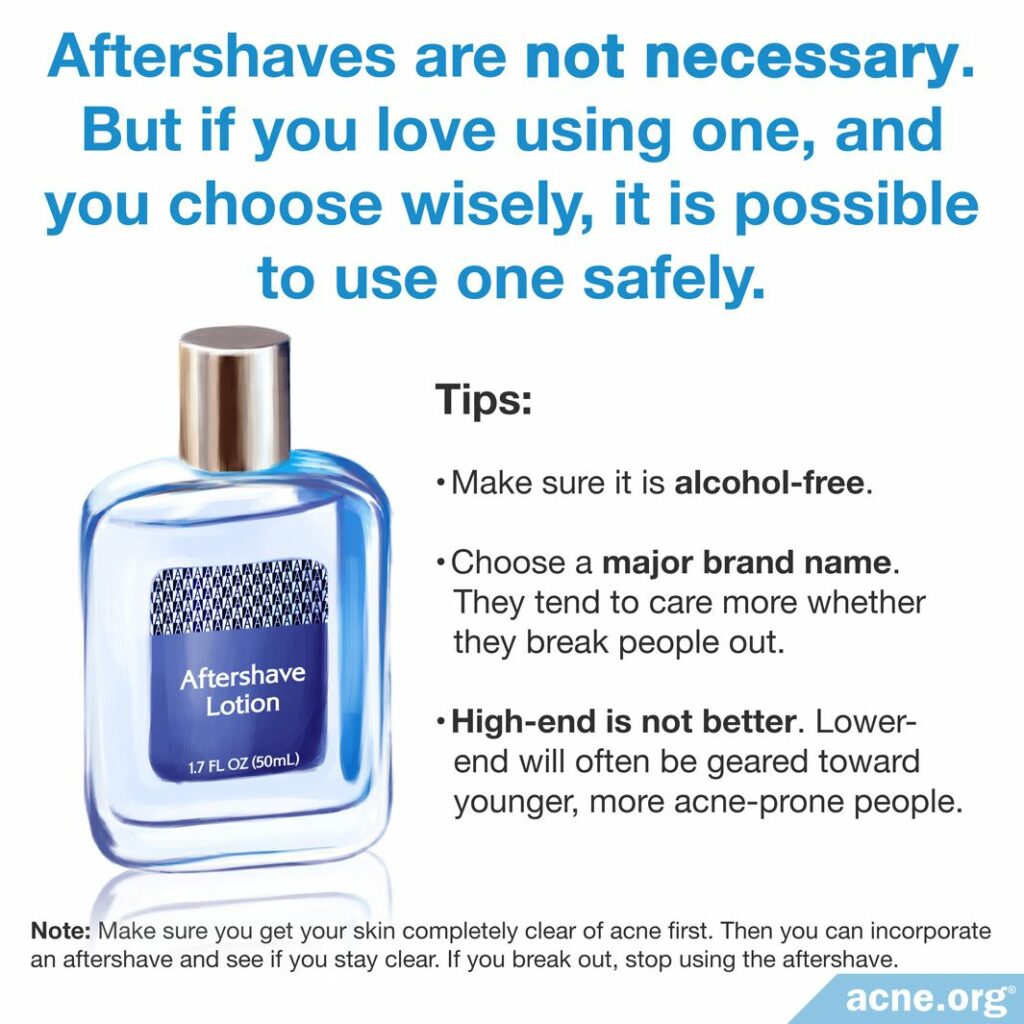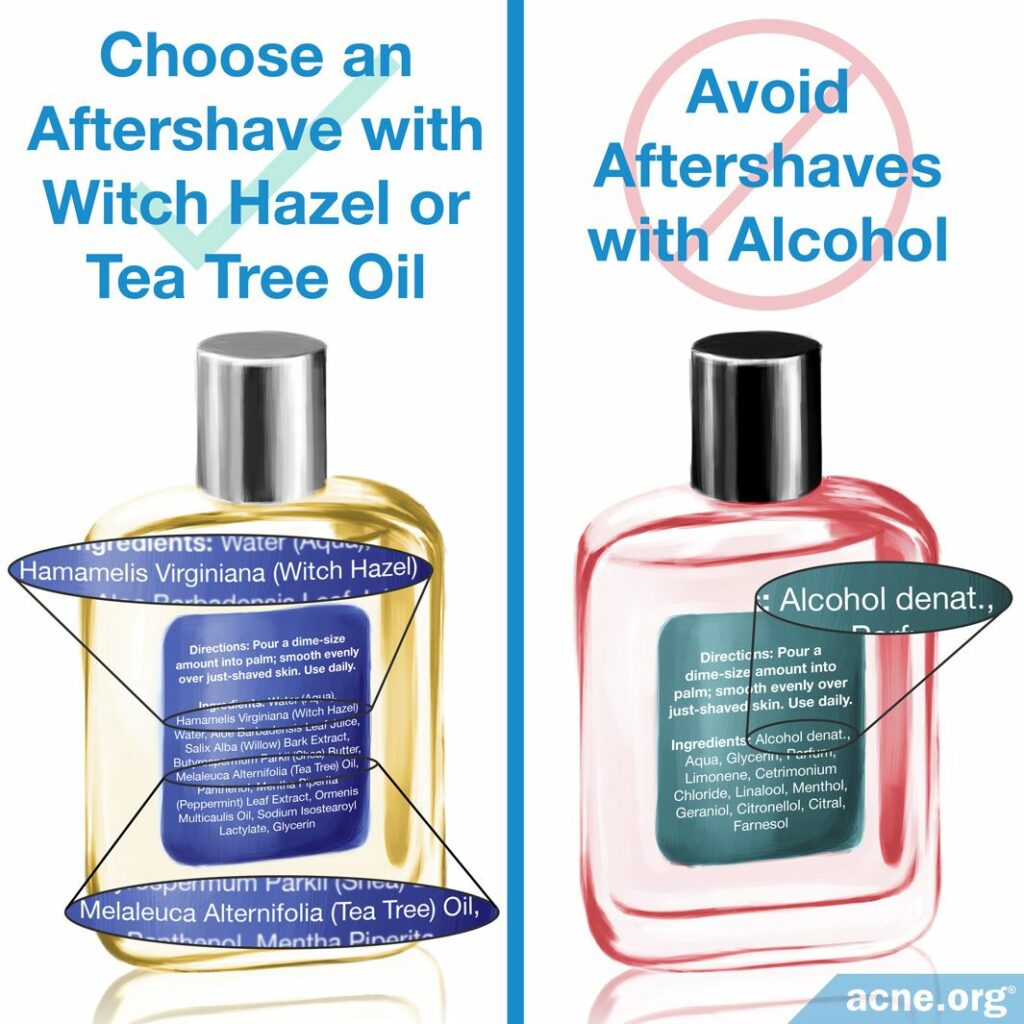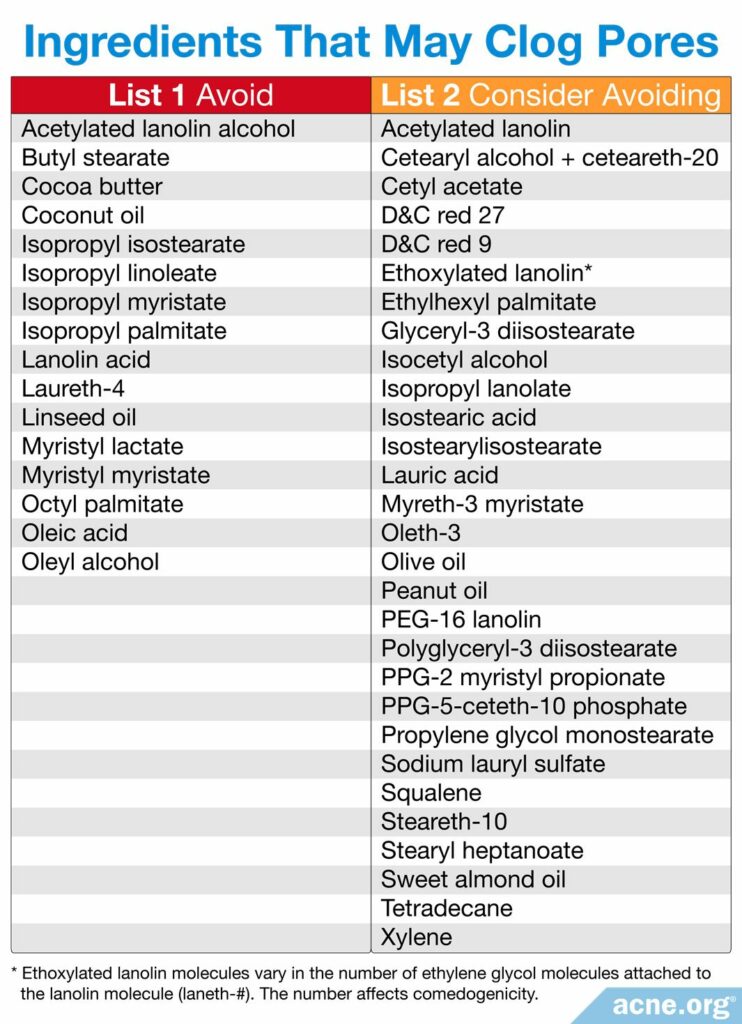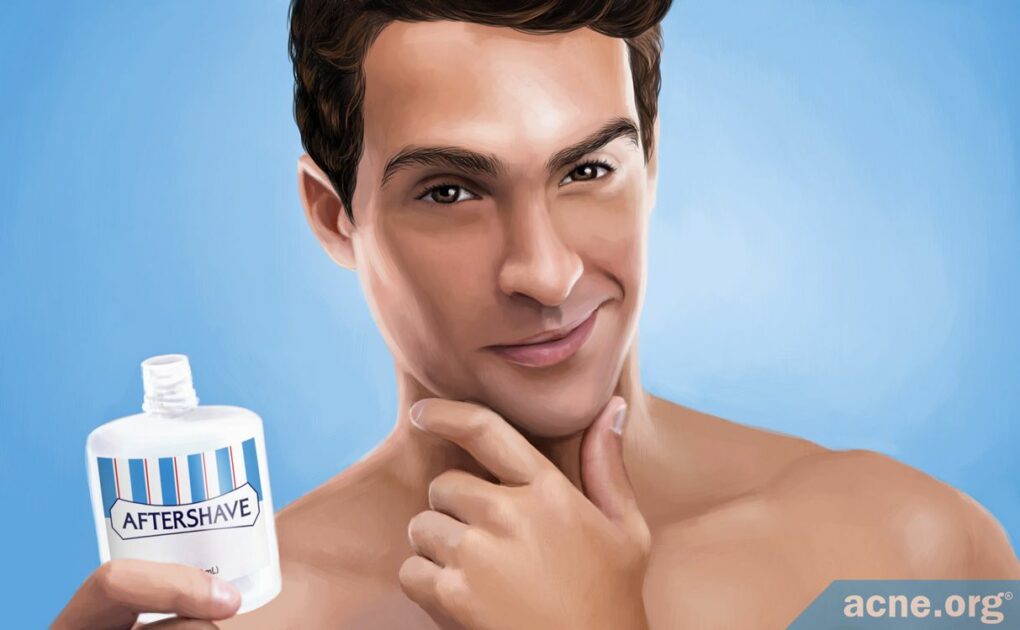Some Aftershaves are Safe to Use, but Make Sure They Are Alcohol-free

The Essential Info
Aftershaves are applied to the skin after shaving to disinfect nicks and cuts and relieve discomfort after shaving. They are unnecessary, but most are safe to use on acne-prone skin as long as they do not contain:
- Alcohol (alcohol can be drying – best to avoid)
- Pore-clogging ingredients (see a full list here)
Note: If you are breaking out at all, don’t use an aftershave. Instead, first concentrate on getting your skin completely cleared up. Once you are clear and have been clear for a few weeks, then it’s safe to add in one variable at a time, such as the addition of an aftershave, and see if you stay clear.
My Experience: I’ve tried aftershaves a few times, but since they don’t perform a necessary function, they seem silly to me. Plus, I figure why not save money and potential irritation from using too many products on my skin.

The Science
- Are the Ingredients in Aftershaves Safe for Acne-prone Skin?
- Antiseptics in Aftershaves
- Soothing Ingredients in Aftershaves
- Watch Out for Pore-clogging Ingredients
- Conclusion
Aftershaves are liquid products applied to the skin after shaving that are meant to perform two main functions:
- Antiseptic: Disinfect nicks and cuts you might get while shaving
- Soothing: Calm irritation in the skin

While an aftershave can feel “refreshing” after a shave, some ingredients in some aftershaves might cause problems for people with acne. For this reason, it is best to first get your acne under complete control before adding an aftershave to your daily regimen. Once you are completely clear of acne, then you can add in an aftershave if you’d like and see if you stay clear. If you break out, you’ll know it’s the aftershave causing the problem.
Are the Ingredients in Aftershaves Safe for Acne-prone Skin?
Some aftershaves contain problematic ingredients. I’ll go into detail about the ingredients commonly included in aftershaves, but if you are pressed for time or just want a quick overview, you can scan the rest of this article for any ingredient mentioned in red, which means it is important to avoid. And also, double check any aftershave you buy against the full list of comedogenic ingredients here at Acne.org.
All aftershaves contain the following two ingredients:
- An antiseptic ingredient: Antiseptics disinfect nicks and cuts. Examples of common antiseptics used in aftershaves include:– Alcohol (potentially drying – avoid alcohol-based aftershaves)
– Witch hazel
– Tea tree oil - A soothing ingredient: Soothing ingredients calm down irritation from shaving. The most common soothing ingredients in aftershaves include:– Aloe
– Witch hazel – both an antiseptic and a soothing ingredient
– Tea tree oil – both an antiseptic and a soothing ingredientYou may be noticing a pattern here. If your aftershave contains witch hazel or tea tree oil, just by containing one of these ingredients it is both antiseptic and soothing.
Aside from an antiseptic and soothing ingredient, sometimes aftershaves also contain:
- A moisturizing ingredient: Some examples of common moisturizing ingredients in aftershaves include:– Glycerin
– Dimethicone
– Mineral oil - Essential oils: Essential oils are scented oils that are sometimes added to aftershaves to give them scent. They are normally harmless to acne-prone skin, and in some cases can even be helpful because they can reduce bacteria and may help provide antioxidants to the skin. Examples of essential oils are:– Lavender oil
– Eucalyptus oil
– Cedarwood oil - Regular oils: Regular oils are sometimes added to aftershaves to improve the feel of the aftershave on the skin. Some regular oils can clog pores, and are thus potentially dangerous for acne-prone skin. Examples of regular oils are:– Coconut oil (pore-clogging – avoid)
– Sweet almond oil (pore-clogging – avoid)
– Peanut oil (potentially pore-clogging – avoid)
– Olive oil (potentially pore-clogging – avoid)
– Sunflower oil
– Safflower oil
– Jojoba oil
Next, since all aftershaves contain an antiseptic and soothing ingredient, let’s have a closer look at those ingredients in particular, starting with antiseptics.
Antiseptics in Aftershaves

Antiseptics are substances used to disinfect the skin. They are helpful when there is a cut or a nick on the skin, such as a cut or a nick after shaving.
The most common antiseptics used in aftershaves are (in order of how often they are used):
- Alcohol (potentially drying – avoid alcohol-based aftershaves)
- Witch hazel
- Tea tree oil
Alcohol is the most common. However, many aftershaves contain both alcohol and witch hazel. As we will see, it’s best to avoid aftershaves with alcohol in them, but witch hazel should be fine.
Alcohol Is A Powerful Antiseptic but Can Dry the Skin
Alcohol is the most common antiseptic used in aftershaves. Unfortunately, it is also the worst antiseptic for acne-prone skin because it dries the skin. Dry skin is much more prone to irritation, which is a big issue because irritated skin increases the chances of acne breakouts. I recommend avoiding alcohol-based aftershaves.
Expand to read about the antiseptic properties of alcohol
Alcohol content in aftershaves: Alcohol content in alcohol-based aftershaves varies widely, but most aftershaves contain at least 30-40% alcohol. The higher alcohol is on the list of ingredients on the back of an aftershave bottle, the more alcohol it will contain. So, if alcohol is the first or second ingredient, you know it’s in there at a high percentage. On the other hand, if alcohol is listed very low on the ingredient list, the aftershave may contain only a small amount of alcohol and may be safer to use.
Witch Hazel Is Less Drying – Choose Aftershaves with Witch Hazel Over Those with Alcohol
Instead of an alcohol-based aftershave, consider one that contains witch hazel instead. Witch hazel disinfects the skin and is much more delicate than alcohol.
Expand to read about the antiseptic properties of witch hazel
Witch hazel content in aftershaves: The U.S. Food and Drug Administration (FDA) recommends that the content of witch hazel in an aftershave lotion should be between 0.9% and 8% for it to be effective as an antiseptic.5 That means if witch hazel is listed in the first 1 or 2 of ingredients on a product’s ingredient list, it is likely included at a high enough amount to do its job.
Tea Tree Oil Is Non-Drying and A Welcome Addition to Aftershaves
Tea tree oil is an alternative antiseptic that you may sometimes find in aftershaves. We have no studies to tell us whether tea tree oil is a better antiseptic compared to witch hazel, but tea tree oil is definitely more delicate to the skin than alcohol. Like witch hazel, tea tree oil both disinfects the skin and calms down the irritation.
Expand to read about the antiseptic properties of tea tree oil
Interestingly, the antiseptic properties of tea tree oil are one of the reasons it is somewhat helpful against acne. Research suggests that tea tree oil at a concentration of 3-5% may help reduce the number of acne lesions, in part because of its ability to limit the growth of acne bacteria.8
Tea tree oil content in aftershaves: The amount of tea tree oil in aftershaves also varies. The higher it is on the ingredient list, the more the aftershave will contain. For tea tree oil to do its best work, you should look for it in the first 7 ingredients on the ingredient list.
Now let’s have a closer look at soothing ingredients.
Soothing Ingredients in Aftershaves
Shaving often irritates the skin and increases the chances of acne breakouts. To calm down the irritation, an aftershave should contain a soothing ingredient.
The most common soothing ingredients in aftershaves are:
- Aloe
- Witch hazel
- Tea tree oil
Some less common soothing ingredients may include:
- Chamomile
- Calendula
- Panthenol
Let’s have a look at the most common soothing ingredients and how they do their job.
Aloe
Aftershaves often contain Aloe because it soothes the skin and helps to reduce the irritation after shaving. However, this is only true of certain types of Aloe. To do its job, it must be 100% Aloe gel. In other words, just because you see Aloe on the list of ingredients doesn’t mean it is performing its job. To learn more, you can read a full article on Aloe here. But suffice it to say that if you see Aloe on an ingredient list, it probably won’t hurt.
Witch Hazel
We have seen that witch hazel is a welcome antiseptic ingredient. However, three studies performed in 1993, 2002, and 2007 show us that witch hazel also has moderate soothing properties. This is good for acne-prone skin because we know that irritation can contribute to acne.
Expand to read full details of the studies
Tea Tree Oil
Tea tree oil has scientifically proven anti-inflammatory activity, which helps soothe the skin after shaving. The anti-inflammatory properties of tea tree oil are down to a specific component, called terpinen-4-ol.12,13 The anti-inflammatory properties of tea tree oil may help in the treatment of various inflammatory conditions, including acne.
However, sometimes tea tree oil is used in tiny amounts in aftershaves simply for fragrance. So just like aloe, just because you see tea tree oil on the label doesn’t mean it’s necessarily going to help. But it also won’t hurt.
Watch Out for Pore-clogging Ingredients
Be sure to check the ingredients on the package carefully to make sure none of them contain the following potentially pore-clogging ingredients.

Avoid Scented Aftershaves if Possible
Research shows that fragrances in skincare products are sometimes a cause of skin irritation. As we have discussed, irritating acne-prone skin can lead to breakouts. Therefore, when possible, look for an aftershave labeled “unscented” or “fragrance-free.”14 One exception is tea tree oil, which has a strong scent, and as we have discussed, is a welcome addition to aftershave.
Conclusion
If you have acne-prone skin, steer clear of alcohol-based aftershaves that can dry the skin and might make acne worse. Instead, use an aftershave that contains witch hazel and/or tea tree oil, and carefully check the list of ingredients on the package to make sure none of them will clog pores.
 & Are Aftershaves Safe to Use on Acne-Prone Skin?
& Are Aftershaves Safe to Use on Acne-Prone Skin?